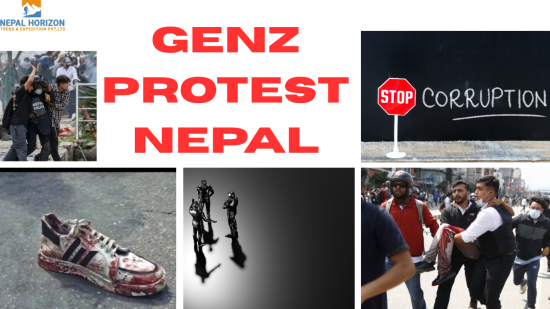Everest Base Camp: Everything You Need to Know About
27th September 2025
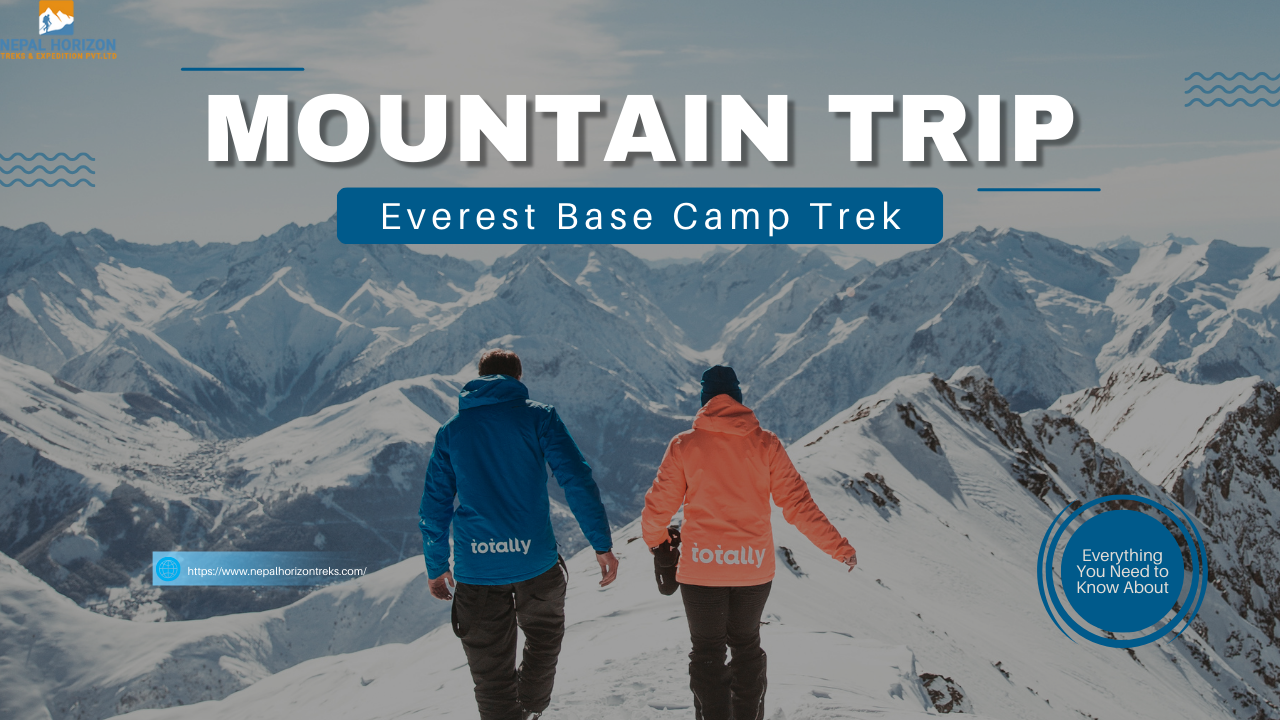
Introduction
Standing at the foot of the world’s highest mountain is not just a dream; it is a Himalaya adventure that defines a lifetime. The Everest Base Camp (EBC journey) is one of the most iconic Nepal trekking experiences, attracting adventurers, travelers, and mountaineers from across the globe. Every year, thousands of travelers walk the trails carved by Sherpa legends to reach the legendary Everest Base Camp at an altitude of 5,364 meters.
This blog is your comprehensive Everest Base Camp guide, covering everything you need to know before embarking on this remarkable adventure: the best time to go, the detailed Everest Base Camp itinerary, permits, accommodation, cultural encounters, and practical tips. If you are planning this journey, Nepal Horizon Trek is here to craft your personalized expedition into the heart of the Himalayas.
Why Choose the Everest Base Camp?
The Everest Base Camp experience is more than just reaching a destination. It is about walking along trails lined with colorful prayer flags, crossing suspension bridges over roaring rivers, visiting ancient monasteries, and sharing moments with the Sherpa communities who have lived in these mountains for centuries.
Highlights include:
- Scenic flight from Kathmandu to Lukla.
- Immersion into Sherpa culture at Namche Bazaar.
- Panoramic views of Everest, Lhotse, Ama Dablam, and Nuptse.
- Sunrise from Kala Patthar, one of the best viewpoints of Mount Everest.
- A spiritual journey with visits to Tengboche Monastery.
This journey combines breathtaking landscapes with cultural depth, making it one of the best adventures in Nepal trekking.
Best Time to Visit Everest Base Camp
Choosing the right season is crucial for a successful expedition.
- Spring (March–May): Clear skies, blooming rhododendrons, and comfortable temperatures. This is the most popular season for the EBC adventure.
- Autumn (September–November): Stable weather, excellent visibility, and festive vibes in Nepal. Perfect for photography and cultural immersion.
- Winter (December–February): Cold temperatures but fewer crowds. A good choice for experienced hikers.
- Summer/Monsoon (June–August): Rain and cloud cover reduce visibility. Trails are slippery, and flights may face delays.
For most adventurers, spring and autumn are the best times to enjoy the Everest Base Camp experience.
Duration of the Everest Base Camp Journey
The EBC route typically takes 12 to 16 days, depending on acclimatization and itinerary preferences. Some travelers prefer a shorter plan with fewer rest days, while others extend their journey with side hikes to Gokyo Lakes or Chhukung Valley.
Nepal Horizon Trek offers customized Everest Base Camp packages to fit your time, budget, and fitness level.
Classic Everest Base Camp Itinerary (14 Days)
Here is a standard Everest Base Camp itinerary:
- Day 1: Flight from Kathmandu to Lukla (2,860 m) → Hike to Phakding (2,610 m).
- Day 2: Walk to Namche Bazaar (3,440 m).
- Day 3: Acclimatization day at Namche Bazaar (hike to Everest View Hotel).
- Day 4: Continue to Tengboche (3,870 m).
- Day 5: Journey to Dingboche (4,410 m).
- Day 6: Dingboche Acclimatization Day (hike to Nagarjun Hill).
- Day 7: Move on to Lobuche (4,910 m).
- Day 8: Reach Gorak Shep (5,164 m) → Visit Everest Base Camp (5,364 m).
- Day 9: Sunrise hike to Kala Patthar (5,545 m) → Return to Pheriche.
- Day 10: Descend to Namche Bazaar.
- Day 11: Continue back to Lukla.
- Day 12: Fly to Kathmandu.
This Everest Base Camp guide is flexible—extra days may be added for acclimatization or side trips.
Trekking Route and Major Stops
- Lukla (2,860 m): Gateway to the EBC adventure, reached via a short but thrilling mountain flight.
- Phakding (2,610 m): First stop with riverside tea houses.
- Namche Bazaar (3,440 m): A bustling Sherpa town with shops, bakeries, and markets.
- Tengboche (3,870 m): Famous for its monastery and panoramic mountain views.
- Dingboche (4,410 m): Known as the “summer valley,” ideal for acclimatization.
- Lobuche (4,910 m): Last overnight stop before base camp.
- Gorak Shep (5,164 m): The final village, leading to Everest Base Camp and Kala Patthar.
- Kala Patthar (5,545 m): Offers the best sunrise views of Everest.
Each stop adds unique experiences, from cultural encounters to breathtaking scenery.
Accommodation and Meals on the Route
Accommodation is provided by tea houses and lodges along the trail. Rooms are basic, usually with twin beds, shared bathrooms, and limited electricity.
Meals typically include:
- Dal Bhat (Nepali rice and lentil dish).
- Noodles, pasta, or fried rice.
- Sherpa stew and soups for warmth.
- Tea, coffee, and sometimes bakery items in Namche Bazaar.
Staying in local tea houses supports the Sherpa economy and offers authentic cultural interactions.
Difficulty Level and Fitness Requirements
The Everest Base Camp adventure is considered moderate to challenging. You don’t need prior mountaineering experience, but good fitness is essential.
- Daily hiking: 5–7 hours on rugged trails.
- Altitude: Up to 5,545 m (Kala Patthar).
- Risks: Altitude sickness, cold weather, and unpredictable conditions.
Fitness tips:
- Train with cardio, hiking, and strength exercises before your journey.
- Take acclimatization days seriously.
- Walk at your own pace.
Cultural Encounters with the Sherpa Community
The Sherpa people are renowned for their resilience, warmth, and deep connection to the Himalayas. During the adventure, you’ll:
- Visit Tengboche Monastery, a spiritual landmark.
- Witness colorful prayer flags and mani stones.
- Experience traditional Sherpa hospitality in tea houses.
These cultural encounters enrich the Everest Base Camp experience, making it more than just a physical challenge.
Safety, Permits, and Guidelines
Permits Required:
- Sagarmatha National Park Entry Permit.
- Khumbu Pasang Lhamu Rural Municipality Permit.
Both are mandatory and can be arranged by Nepal Horizon Trek.
Safety Guidelines:
- Always hike with a licensed guide.
- Stay hydrated and avoid alcohol at high altitude.
- Be aware of symptoms of altitude sickness.
With Nepal Horizon Trek, your safety is the top priority.
Gear and Packing Tips
Packing smarts ensures a comfortable EBC journey.
- Clothing: Layered clothing (base, mid, outer), down jacket, thermal wear.
- Footwear: Hiking boots, warm socks, gaiters.
- Gear: Sleeping bag (-10°C), trekking poles, headlamp.
- Essentials: Water purifier, sunscreen, first-aid kit, personal medications.
Lightweight but warm gear is key for the Himalayan climate.
Cost of the Everest Base Camp Experience
The cost depends on itinerary, group size, and services. On average, the Everest Base Camp journey costs between $1,200 to $1,800 per person, covering permits, guides, accommodation, meals, and flights.
Nepal Horizon Trek offers affordable and customized EBC packages to suit your preferences.
Meet Our Team of Experts
At the heart of every great expedition is a team that ensures your safety, comfort, and adventure. Our experienced Sherpa guides, porters, and support staff make the Everest Base Camp experience both safe and memorable.
Learn more about our dedicated guides and crew on our our-team page.
Other Travel Services Beyond Nepal
While the EBC adventure is our most popular package, we also design journeys beyond Nepal’s borders. Many of our travelers combine their Himalayan adventure with a visit to the Kingdom of Bhutan.
Explore our Bhutan travel services and discover the Land of the Thunder Dragon with Nepal Horizon Trek.
Travel Recommendations
- Insurance: Always buy travel insurance covering high-altitude expeditions.
- Guides and Porters: Hiring them ensures safety and supports the local economy.
- Preparation: Book flights early, as Lukla flights can be weather-dependent.
Conclusion
The Everest Base Camp journey blends breathtaking landscapes, cultural encounters, and the thrill of standing at the base of the world’s tallest mountain. It is a dream adventure for travelers worldwide and a must-do Himalaya experience for anyone passionate about exploring.
📞 Contact Us
Planning your Everest Base Camp adventure or any other Himalaya journey? We’re here to help you every step of the way. Contact with us today!
Address: Thamel, Chhetrapati, Kathmandu, Nepal
Phone: +9779851183849, +977-01-4268273
Email: info@nepalhorizontreks.com
Website: https://www.nepalhorizontreks.com
Plan Your Everest Base Camp Adventure with Nepal Horizon Trek
FAQs About Everest Base Camp Adventure
1. How difficult is the Everest Base Camp route?
It is moderate to challenging. Good fitness and preparation are required, but no prior mountaineering experience is necessary.
2. How long does the EBC journey take?
Typically 12–16 days, depending on acclimatization and itinerary choices.
3. Do I need permits for the expedition?
Yes, you need the Sagarmatha National Park Permit and Khumbu Rural Municipality Permit.
4. What is the best time for the Everest Base Camp experience?
Spring (March–May) and autumn (September–November) are ideal due to stable weather and clear skies.
5. Can I do the journey solo?
Yes, but hiring a licensed guide is highly recommended for safety, navigation, and cultural insights.
6. What is the highest point of the route?
Kala Patthar (5,545 m), which offers the best views of Mount Everest.
Related Journeys You May Like
If you’re interested in exploring other Himalayan adventures, check out our detailed blog on:
Annapurna Base Camp Trek Itinerary & Packages 2025: Routes, Cost, Best Time & Days Guide
Recent From Blogs

7th October 2025

27th September 2025
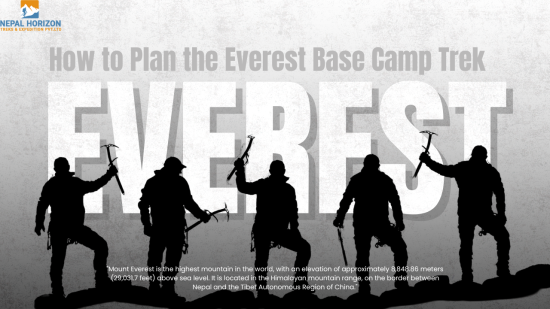
25th September 2025

22nd September 2025
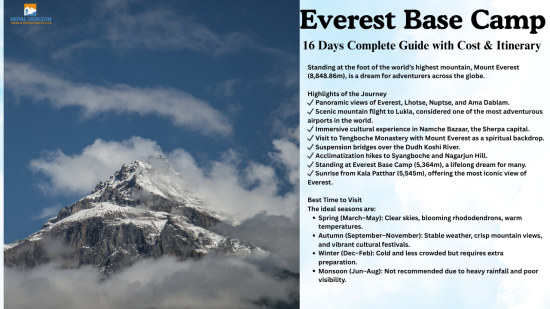
20th September 2025

17th September 2025
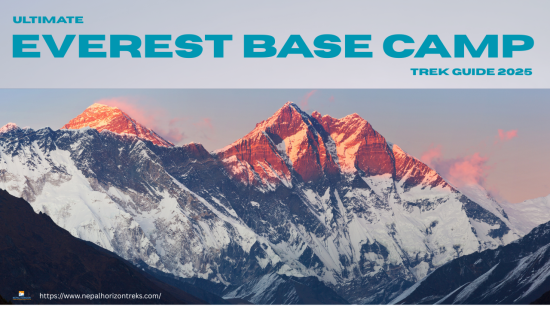
15th September 2025
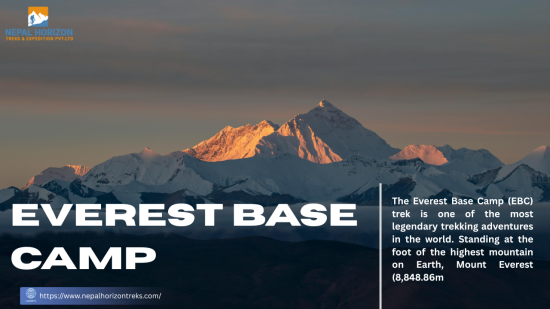
13th September 2025
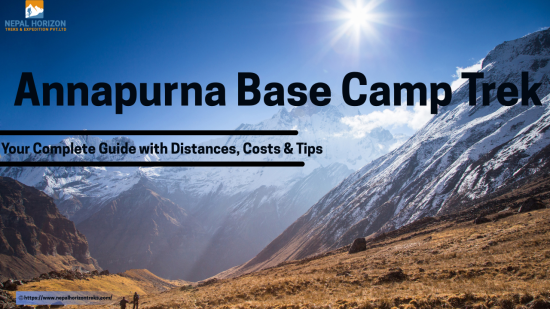
11th September 2025
